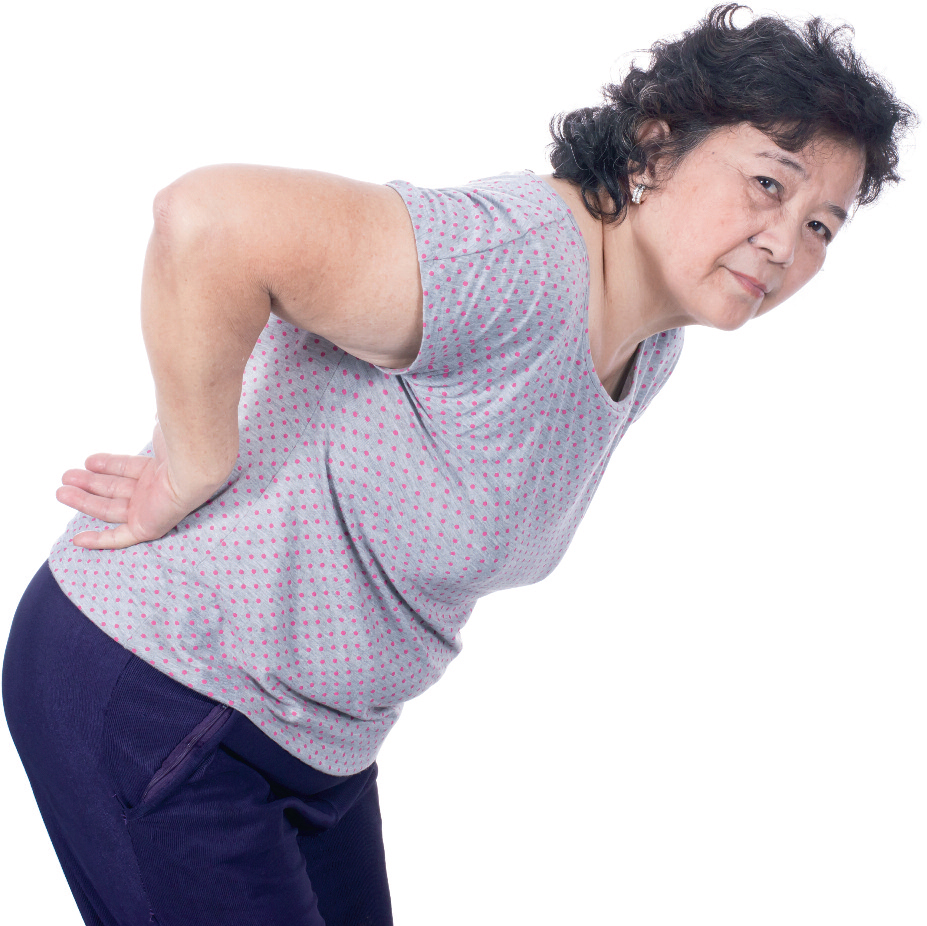The cost of back and joint pain
In Insight
Follow this topic
Bookmark
Record learning outcomes
More than 10 per cent of UK adults care for a friend or family member, and it is thought that a high proportion of them suffer with back pain. This is one group that needs support.
 More than 10 per cent of UK adults care for a friend or family member, and nearly three-quarters of them suffer with back pain. By providing advice and support, community pharmacy can grow customer loyalty and market share. Getting to know your regular customers can be beneficial for them and for your business.
More than 10 per cent of UK adults care for a friend or family member, and nearly three-quarters of them suffer with back pain. By providing advice and support, community pharmacy can grow customer loyalty and market share. Getting to know your regular customers can be beneficial for them and for your business.
Carers are particularly at risk of physical problems, such as back and joint pain. According to the charity BackCare, 70 per cent of unpaid carers suffer from back pain, and replacing just one injured carer costs social services thousands of pounds. Councils are now legally obliged to take steps to prevent injury to carers, following the Care Act (clause 2), which came into effect in April 2015, and BackCare has produced a Carer's Guide to safer moving and handling of people for unpaid or family carers.
Women more at risk
The onus of caring for elderly relatives often falls on middle-aged women, and Mentholatum is reaching out to this age 55+ demographic with a three-month advertising campaign for Deep Relief Pain Relief Gel, expected to be seen by 4.3 million women. The campaign will run in national press and magazines until the end of November.
It's not just carers who are reporting back and neck pain, according to the British Chiropractic Association (BCA). Its research, based on 2,127 British adults aged 18 to 65, revealed that 71 per cent of those suffering with back pain had done so for up to 10 years, and many admitted to taking no proactive measures to take care of their backs. Back pain has caused almost 30 per cent of people to take time off work €“ 9.9 million working days were lost to back problems last year alone.
Only 7 per cent of back pain sufferers seek professional advice, while nearly half say they reach for heat muscle creams and patches or simply rest, while two-fifths rely on over-the-counter medications.
Suffering in silence
The BCA research confirms that most people with back and joint pain self-medicate. If members of your pharmacy team notice someone repeatedly purchasing pain-relief medication, it puts you in a good position to discuss their needs, or refer them to a GP or other health professional if appropriate.
€Although the pharmacist is well-placed to provide first-line advice on the management of the different types of pain, recent UK research (involving 2,000 adults) revealed around half of sufferers have rarely or never sought advice from a pharmacist,€ says Craig Shaw, RB marketing director for Nurofen.
€Pharmacy can grow its market share by providing the services and products that its communities need,€ says Mr Shaw, €by ensuring staff are trained in pain management, and by making the most of available space so that consumers can find what they want quickly and identify what they need from fixtures that can be confusing,€ he says.
Consumers expect to be able to find a range of pain solutions quickly and to be able to get advice from the pharmacy team. Mr Shaw suggests that better communication, and using techniques such as motivational interviewing, may increase patient engagement and encourage patients to seek advice from the pharmacy in the future.
€There is nothing more credible than a recommendation from a health professional,€ he says. €If consumers leave the pharmacy feeling that they are better informed about their health, they will return. €Pharmacists need to open up that conversation with the consumer and be able to offer that individual the personal service that the big retailers just can't do.€
The RBforhealth.com pharmacists' portal has more advice about maximising sales opportunities, and advice on pain management techniques and appropriate treatments.
Market developments
Omega Pharma, the maker of Solpadeine, is running a number of interactive pharmacy training evenings in November to help pharmacists maximise the full potential of P-medicines, including pain relief options. P-medicines can play a central role in helping pharmacy to support people with back and joint pain and relieve some of the pressure on NHS services.
The programme, which is running nationwide until mid November, is helping pharmacists to better manage their P-medicine offering, by providing advice and support to encourage conversations about the use of these medicines. Pharmacists and assistants can access the pain category and Solpadeine training modules on Omega Pharma's training portal.
Physical-based treatments continue to grow, according to brand managers at Mentholatum, and in order to cater for this market, Deep Heat Muscle Massage has been designed to combine heat therapy and physical massage. €We believe that the new Deep Heat Muscle Massage Roll-on Lotion will stimulate renewed interest in the heat category, which is dominated by Deep Heat, and that it will bring in new users,€ says Dagny Graham, group product manager for Mentholatum.
The launch of the new product is supported with a national advertising campaign, which began in October, including consumer print advertising in magazines, participation at exhibitions and events, including the 2016 London Marathon Expo. There will also be consumer and trade PR campaigns and a #rollonrelief digital campaign.
The Nelsons Arnicare Bring Back the Bathroom Cabinet campaign has been running since the summer, including print advertising in women's lifestyle titles and advertisements in play centres. €We know our target audience are very busy, which is why we have adopted an integrated approach to our campaign to try and reach them where they have some time,€ says Arnicare brand manager Emma Wright.
Salonpas Pain Relief Patches are currently being promoted online and on public transport in major cities, emphasising their effectiveness when used for back pain and joint pain.
Comment
 Vishal Mashru, VM Pharmacy Services, Leicester €This category is important, especially at this time of year. Generally, it's back pain or back-related problems and joint and knees and hip pain, especially in older people. We tend to recommend an anti-inflammatory, if they can take it, or paracetamol, just depending on the type of pain. If it's a nerve-type pain, then co-codamol tends to be better because it blocks the pain better. We also recommend Tens machines, but these can have a mixed reception when people would rather stay with the remedies they know. But many people who've tried this method say it's worked and that they will use it again. This is a hard category to keep up to date with because there seems to be a constant stream of changes. This is true of joint and back pain in particular, for example the products that have been removed recently because of heart problems.€
Vishal Mashru, VM Pharmacy Services, Leicester €This category is important, especially at this time of year. Generally, it's back pain or back-related problems and joint and knees and hip pain, especially in older people. We tend to recommend an anti-inflammatory, if they can take it, or paracetamol, just depending on the type of pain. If it's a nerve-type pain, then co-codamol tends to be better because it blocks the pain better. We also recommend Tens machines, but these can have a mixed reception when people would rather stay with the remedies they know. But many people who've tried this method say it's worked and that they will use it again. This is a hard category to keep up to date with because there seems to be a constant stream of changes. This is true of joint and back pain in particular, for example the products that have been removed recently because of heart problems.€
 Rena Dadra, Village Pharmacy, Harlington €We now have a large pain management section in our pharmacy, so we keep all the Voltarol range and all the gels, Deep Heat, Deep Freeze and Cura- Heat, as well as an own-brand range. In fact, we've only recently implemented this, when we realised this was the way we needed to go. With people exercising more, the main aches and paints now tend to be sportsrelated, so it makes sense to stock more of those sorts of products. Giving the right product is critical: of course you don't want patients coming back saying it didn't work. The right product and the right advice are key. Popularity really depends on what's being advertised at that time. People often come in and ask whether we have that new product that's being talked about on television.€
Rena Dadra, Village Pharmacy, Harlington €We now have a large pain management section in our pharmacy, so we keep all the Voltarol range and all the gels, Deep Heat, Deep Freeze and Cura- Heat, as well as an own-brand range. In fact, we've only recently implemented this, when we realised this was the way we needed to go. With people exercising more, the main aches and paints now tend to be sportsrelated, so it makes sense to stock more of those sorts of products. Giving the right product is critical: of course you don't want patients coming back saying it didn't work. The right product and the right advice are key. Popularity really depends on what's being advertised at that time. People often come in and ask whether we have that new product that's being talked about on television.€
 Ranjit Mann, Ringwood Pharmacy, Coventry €This is one of our bread-andbutter categories: everyone gets aches and pains. We have a fairly elderly population in this area and they tend to use quite a lot of analgesics. Voltarol is our big seller, followed by Deep Heat. We've had a lot of promotion on the various remedies for aches and pains in recent months. The crucial thing to get right is to make sure you have the right symptoms being treated as well as giving the right education. It's important to diagnose the right type of pain and differentiate whether it is muscle or joint pain, to recommend the right products.€
Ranjit Mann, Ringwood Pharmacy, Coventry €This is one of our bread-andbutter categories: everyone gets aches and pains. We have a fairly elderly population in this area and they tend to use quite a lot of analgesics. Voltarol is our big seller, followed by Deep Heat. We've had a lot of promotion on the various remedies for aches and pains in recent months. The crucial thing to get right is to make sure you have the right symptoms being treated as well as giving the right education. It's important to diagnose the right type of pain and differentiate whether it is muscle or joint pain, to recommend the right products.€
